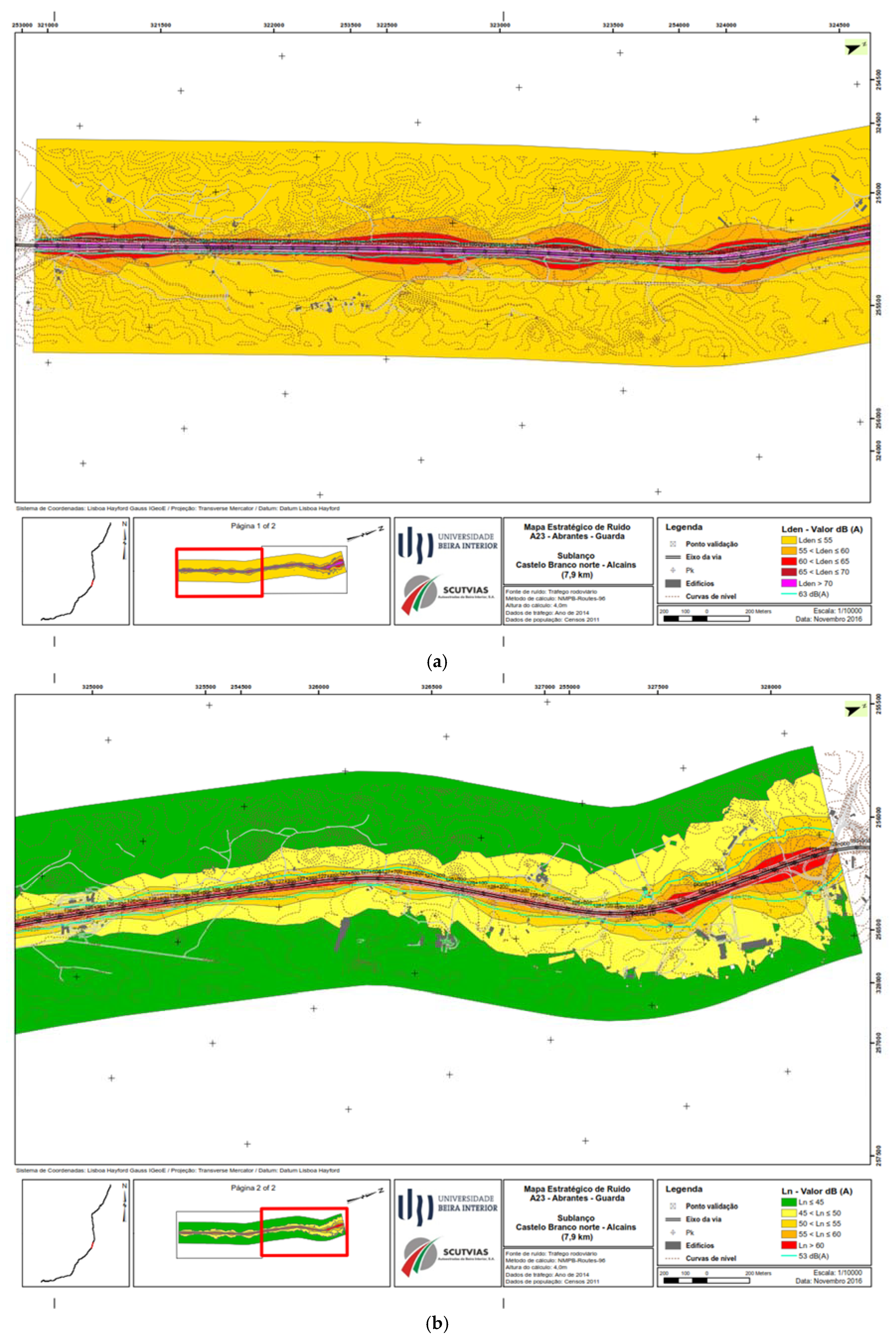Modeling and Mitigation of Noise on the A23 Motorway Using GIS †
Abstract
:1. Introduction
2. Materials and Methods
3. Results and Discussion
4. Conclusions
Author Contributions
Acknowledgments
Conflicts of Interest
References
- Kinsler, L.E.; Frey, A.R.; Coppens, A.B.; Sanders, J.V. Fundamentals of Acoustics, 4th ed.; Kinsler, L.E., Frey, A.R., Coppens, A.B., Sanders, J.V., Eds.; Wiley-VCH: Hoboken, NJ, USA, 1999; 560p, ISBN 0-471-84789-5. [Google Scholar]
- Banfi, S.; et al. External Cost of Transport: Accident, Environmental and Congestion Costs in Western Europe; INFRAS and IWW: Zürich/Karlsruhe, Switzerland and Germany, 2000. [Google Scholar]
- Schreyer, C.; Schneider, C.; Maibach, M.; Rothengatter, W.; Doll, C.; Schmedding, D. External Cost of Transport; 2004; Update study. [Google Scholar]
- WHO. Preamble to the Constitution of the World Health Organization as adopted by the International Health Conference, New York, 19–22 June 1946; WHO: Geneva, Switzerland, 1946; 2p.
- European Parliament and Council of the European Union. Assessment and Management of Environmental Noise (EU Directive); No. L189; Offical Journal of the European Communities: Brussels, Belgium, 2002; pp. 12–25. [Google Scholar]
- ISO. ISO 1996-1: Acoustics—Description, Measurement and Assessment of Environmental Noise—Part 1: Basic Quantities and Assessment Procedures; ISO: Geneva, Switzerland, 2003. [Google Scholar]
- CERTU, CSTB, LCPC, and SETRA. Bruit des Infrastructures Routières: Méthode de Calcul incluant les Effets Météorologiques, Version Expérimentale NMPB-Routes-96; J. Off. du 10 mai 1995, Artic. 6o French Stand. ‘XPS 31-133’; Cetur-Centre Etud Transp: Alairac, France, 1997; p. 98. [Google Scholar]
- Dutilleux, G.; Defrance, J.; Ecotière, D.; Gauvreau, B.; Bérengier, M.; Besnard, F.; Duc, E.L. NMPB-routes-2008: The revision of the french method for road traffic noise prediction. Acta Acust. United Acust. 2010, 96, 452–462. [Google Scholar] [CrossRef]
- Instituto Nacional de Estatística. Censos 2011 Resultados Definitivos—Portugal; Instituto Nacional de Estatística: Lisboa, Portugal, 2011. [Google Scholar]

| Average Daily Traffic 2016 | Vehicle | Light | Heavy | Light | Heavy | Light | Heavy | Light | Heavy |
|---|---|---|---|---|---|---|---|---|---|
| Dist. (km) | 07:00–20:00 | 20:00–23:00 | 23:00–07:00 | Total | |||||
| Cast. B. Norte–Alcains | 7.9 | 7249 | 610 | 931 | 78 | 665 | 123 | 8845 | 811 |
| P. | Measured | Simulated | Difference (in Modulus) | |||
|---|---|---|---|---|---|---|
| 1 | 61.84 | 54.8 | 62.08 | 53.68 | 0.24 | 1.12 |
| 2 | 54.07 | 46.4 | 56.5 | 48.4 | 2.46 | 2.0 |
| 3 | 61.55 | 52.6 | 63.4 | 55.4 | 1.9 | 2.8 |
| 4 | 70.65 | 59.5 | 69.4 | 61.0 | 1.3 | 1.5 |
| 5 | 68.26 | 59.1 | 68.0 | 59.7 | 0.3 | 0.6 |
| LRden | LRn | ||||||
|---|---|---|---|---|---|---|---|
| Range | People | Buildings | Exhibition Area | Range | People | Buildings | Exhibition Area |
| 55 < LRden ≤ 60 | 235 | 67 | 5.94 | 45 < LRn ≤ 50 | 264 | 88 | 5.13 |
| 60 < LRden ≤ 65 | 70 | 20 | 0.94 | 50 < LRn ≤ 55 | 105 | 34 | 1.49 |
| 65 < LRden ≤ 70 | 4 | 1 | 0.47 | 55 < LRn ≤ 60 | 8 | 3 | 0.60 |
| 70 < LRden ≤ 75 | 0 | 0 | 0.22 | 60 < LRn ≤ 65 | 0 | 0 | 0.27 |
| LRden > 75 | 0 | 0 | 0.25 | 65 < LRn ≤ 70 | 0 | 0 | 0.31 |
| LRn > 70 | 0 | 0 | 0 | ||||
Publisher’s Note: MDPI stays neutral with regard to jurisdictional claims in published maps and institutional affiliations. |
© 2018 by the authors. Licensee MDPI, Basel, Switzerland. This article is an open access article distributed under the terms and conditions of the Creative Commons Attribution (CC BY) license (https://creativecommons.org/licenses/by/4.0/).
Share and Cite
Carvalho, A.; Cavaleiro, V.; Albuquerque, A.; Silva, F. Modeling and Mitigation of Noise on the A23 Motorway Using GIS. Proceedings 2018, 2, 1306. https://doi.org/10.3390/proceedings2201306
Carvalho A, Cavaleiro V, Albuquerque A, Silva F. Modeling and Mitigation of Noise on the A23 Motorway Using GIS. Proceedings. 2018; 2(20):1306. https://doi.org/10.3390/proceedings2201306
Chicago/Turabian StyleCarvalho, António, Victor Cavaleiro, António Albuquerque, and Flora Silva. 2018. "Modeling and Mitigation of Noise on the A23 Motorway Using GIS" Proceedings 2, no. 20: 1306. https://doi.org/10.3390/proceedings2201306
APA StyleCarvalho, A., Cavaleiro, V., Albuquerque, A., & Silva, F. (2018). Modeling and Mitigation of Noise on the A23 Motorway Using GIS. Proceedings, 2(20), 1306. https://doi.org/10.3390/proceedings2201306








